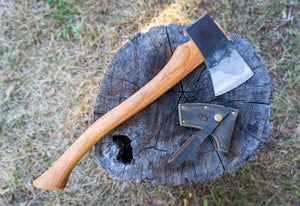
File, Hone & Oil: How to Sharpen An Axe
Chop, chop, chop!
"Give me six hours to chop down a tree and I will spend the first four sharpening the axe."
Sure, you've heard some version of this quote often attributed to Abraham Lincoln. (There's no evidence that Lincoln said this. It's likely an old logging adage.) In its most literal interpretation, the quote tells us a sharp axe gets work done faster. More time sharpening your tool now means less time chopping later.
A dull axe makes chopping harder and could spell danger. Dull blades tire you out as you put in more effort for the same result, and they could glance off the wood and injure you. After heavy use, you should sharpen your axe to maintain its performance.
Is your axe working as well as you remember?
Whether you’re chopping wood for winter or splitting firewood at a campsite, don’t settle for a dull blade. Learn how to sharpen it!
Discover which axe sharpening tools you need and how to sharpen your axe at home. With these tips, you can maintain your axe for years.
Must-Have Axe Sharpening Tools
Does your axe need to be sharp—and how sharp are we talking? That depends on the type of axe you have.
Felling axes, hatchets and the like need to be sharp to work well. If you use a carving axe, its blade must be sharper to perform its function. On the other hand, splitting axes don’t need sharp edges, as blunt blades help break wood in two.
Before you grab a kitchen knife sharpener, consider the angle of the sharpener and your axe. Most knife sharpeners have a fixed angle that works only for knives.
Your axe has a different shape than a kitchen knife. The edge of an axe is a convex shape and its thickness changes from cheek to bit to edge. Many axes have a 30 to 40-degree angle at the bit and a 15 to 20-degree angle closer to the cutting edge.
When you’re ready, gather these axe sharpening tools:
- Sandpaper. Use it to knock off any rust on your blade.
- Bastard file. A flat mill file at least 8” long will help you buff out nicks.
- Honing puck or stone. You’ll want a few of these, ranging from coarse to fine grit, to remove chips and leave a smooth finish.
- Leather strop. This tool polishes and refines the blade’s edge.
What’s the best way to sharpen an axe? Old school. We recommend sharpening your axe by hand with the tools listed above. Heat from a bench grinder could affect the temper of the steel blade.
3 Types of Honing Pucks
There are many honing pucks and whetstones available on the market. You can experiment to find what works best for you and how you want to care for your blade.
- Diamond sharpening stones are more aggressive sharpeners, offering a less polished finish. You can use them with water, oil or even dry—handy if you’re reserving water at your campsite.
- Synthetic waterstones must be saturated with water to work their magic. They provide an excellent finish but may wear faster if you sharpen your axe often.
- Benchstones work with oil to sharpen your blade and remove damage.
You’ll want a few stones of varying grit levels for different purposes. A honing puck or whetstone under 1,000 grit is best for removing damage from the blade. Stones between 1,000 and 3,000 grit help sharpen edges. You’ll want a finer stone around 8,000 grit to get a smooth, polished finish.
Once you’ve selected your stone or pucks, it’s time to get your hands dirty and start sharpening!
How to Sharpen An Axe by Hand
Follow these steps to sharpen your axe blade.
You can hold your axe in your hands while you sharpen it or use a clamp to hold it in place. If you use a clamp or small bench vise, put soft jaws over the edges so the metal doesn't harm your wooden handle.
7 Steps to Sharpen An Axe With A Bastard File
- Prepare your blade. Feel along the blade for nicks or dents you need to file. If the blade has rusted, use sandpaper to remove the rust.
- Set the axe file on the blade. You should have one hand on the handle and one hand on the end of the file.
- Push forward along the blade’s angle. Do not swipe the bastard file back and forth. Only push forward in one direction.
- Keep count. Track how many times you go over the blade with the file.
- Repeat steps 2-4 on the other side of the blade. You will pass the file over this side of the blade the same number of times as before.
- Use a file card. If you notice dust or metal shavings getting stuck on your file, use a file card to remove them. Brush parallel to the teeth on the file. Then, you can continue sharpening your axe.
- Bring out the honing puck. Once nicks are gone, you can work along the blade with a honing puck. Rub the puck in a circular motion along the blade. See more guidelines for using a honing puck in the next section.
10 Steps to Using Honing Pucks
- Select your puck. Grab your medium to aggressive honing puck to start.
- Get it wet. Saturate your honing puck with water.
- Set up for sharpening. Hold the axe with its blade parallel to the ground or use a bench vise to hold it in one place.
- Rub the honing puck against the blade in a circular motion. Use light pressure as you start at one end of the blade and move to the other end.
- Count the number of passes you make. Keep track so you can make the same number of passes on the other side.
- Flip the blade over and repeat steps 3-5. Pass over this side of the blade the same number of times as you did before.
- Change pucks. Grab your fine honing puck to polish.
- Repeat steps 2-6. Do everything you did before but with the fine puck. Wet the puck if needed. Rub it against the blade in a circular motion and count your passes.
- Remove moisture. Once you are done, clean any moisture off of the axe before storing it.
- Chop away!
Further Care for Your Axe
Caring for your axe doesn’t stop at sharpening. You can also apply preventative oils or waxes to protect its steel blade and wooden handle. Camellia oil works to prevent rust on the blade. After sharpening, you can apply a thin layer to protect the steel.
Don’t forget about the handle! Wood can dry out over time. The last thing you want is a cracked handle that makes holding the axe uncomfortable. Linseed oil helps keep wooden handles in tip-top shape.
Fair warning: Be careful with linseed oil. Only use a fine sheen applied with a clean rag. Once applied, immediately remove the oil by wiping it off with another clean rag. Linseed oil rags can self-combust, so air them out to dry or put them in water to be safe.
How Long Does It Take to Sharpen An Axe?
Sharpening a well-maintained axe may only take five to 20 minutes.
If you’ve never sharpened your axe before or it’s been a while, you might be working on it for several hours. Once you’ve invested the initial time, sharpening will go faster in the future as part of your axe’s ongoing maintenance. Just remember to sharpen regularly!
How Often Should I Sharpen My Axe?
You should sharpen your axe when you notice it isn’t working the way it should. When it takes more effort to use your axe, that’s an indicator your blade is getting dull.
How frequently you use the axe will dictate how often you need to sharpen it. For an axe you don’t use often, you likely only need to sharpen it every three to six months.
Find Your Axe Made in Heaven
Discover your perfect match—a handmade heirloom axe!
Crane’s Country Store has Maine-made Brant & Cochran axes if you’re looking for an expertly crafted hand tool. These axes are wicked sharp and made with U.S.-sourced steel.
The Dirigo Belt Axe is for camping, canoeing and all outdoor adventures in between. Pack it for splitting kindling at camp, or keep it around for feeding firewood to your wood stove. You’ll love its beautiful 17” hickory handle.
Are you looking for a larger axe? The Allagash Cruiser is for serious chopping, staying sharp after hours of use. With a 28” Amish-turned hickory handle, you’ll find new joys in cutting wood.
Apply the steps you learned from this article and care for your axe with a Field Kit! The field kit includes essentials for your axe: an 8” bastard axe file, dual grit honing puck, bit wax and handle wax. You’ll have the necessary tools to keep cutting wood efficiently.
Shop Crane’s Country Store online or visit our storefront near Columbia, MO. We have what you need to be a successful backyard lumberjack.









